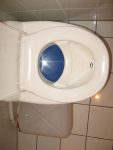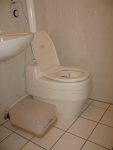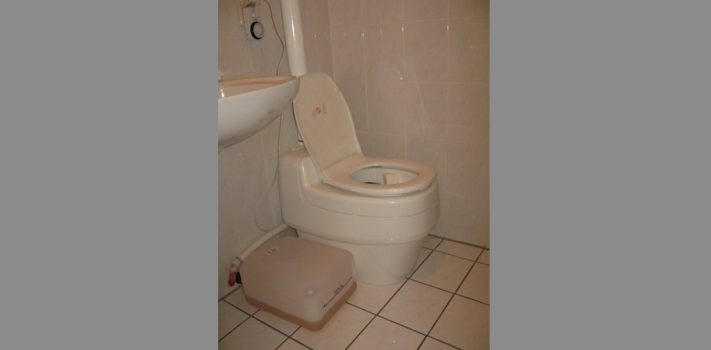Not the most comfortable topic to discuss but closing up the cabin last week I realized that our toilet has been problem-free for many years and worthy of a brief review to share with the readers of SurvivalBlog. I did not receive any compensation for this review, and we purchased this unit four years ago and have been using it regularly.
We installed a composting toilet in our cabin several years ago for those times we didn’t want to trudge 300′ through the snow to the outhouse. My wife and I watched numerous video reviews of different composting toilets in tiny houses. Quite frankly many of them were disgusting to watch with cranking handles to stir up the mixture, adding sawdust, or dumping buckets. Some of the toilets sat up on a riser so you had to step up to sit on it. Then we ran across the Swedish-made composting toilet called the “Separett”. It is named as such because the urine is separate from the solid waste (“poo”). We learned if you remove the urine from the poo, the odor will dissipate in short order.
 How it works is you sit on the toilet the seat has a slight spring-loaded operation that moves a door clear of the back end (we’ll call it the poo end). In other words, if you lift the lid of the toilet, you see the seat and a blue door under the seat. Pushing down on the seat the door will pivot clear where you can see into the toilet and the poo. In the toilet is an approximately 3-gallon plastic container that will rotate a few degrees each time with the operation of the door. This is to prevent poo piling in one spot (yea, I know, haha). Inside of the bucket a composting plastic bag is placed to catch the poo. In the back of the toilet is a fan with a filter screen that pulls odor from within the toilet to the outside. For our system, I ran the 3” PVC pipe up into the second floor into a 90-degree elbow exiting through an outside wall. The fan can run on 12 volts DC or from a 120 volts AC household power supply. We leave it run 24/7 and only had to clean the screen once of mostly dust it pulls from within the cabin.
How it works is you sit on the toilet the seat has a slight spring-loaded operation that moves a door clear of the back end (we’ll call it the poo end). In other words, if you lift the lid of the toilet, you see the seat and a blue door under the seat. Pushing down on the seat the door will pivot clear where you can see into the toilet and the poo. In the toilet is an approximately 3-gallon plastic container that will rotate a few degrees each time with the operation of the door. This is to prevent poo piling in one spot (yea, I know, haha). Inside of the bucket a composting plastic bag is placed to catch the poo. In the back of the toilet is a fan with a filter screen that pulls odor from within the toilet to the outside. For our system, I ran the 3” PVC pipe up into the second floor into a 90-degree elbow exiting through an outside wall. The fan can run on 12 volts DC or from a 120 volts AC household power supply. We leave it run 24/7 and only had to clean the screen once of mostly dust it pulls from within the cabin.
 The unique part of this toilet is the front part where the urine enters is separate from the poo bucket. The urine trap looks like a small drain that is connected to a tube inside of the toilet and runs out the back to an outside drain. A small hole is drilled through the wall to drain into a French drain. In my case, I installed a 1” or 1 1/4” electrical LB fitting on the side of the cabin that drops down into an underground French drain. The tubing that exits the toilet makes a loop (a trap to prevent odors from the French drain) before exiting the cabin. Unlike typical residential installations in Sweden (as shown in the photos), I simply fed the tubing into the back of the fitting from the inside and the urine drops out of the tube and downward into the electrical conduit into the French drain.
The unique part of this toilet is the front part where the urine enters is separate from the poo bucket. The urine trap looks like a small drain that is connected to a tube inside of the toilet and runs out the back to an outside drain. A small hole is drilled through the wall to drain into a French drain. In my case, I installed a 1” or 1 1/4” electrical LB fitting on the side of the cabin that drops down into an underground French drain. The tubing that exits the toilet makes a loop (a trap to prevent odors from the French drain) before exiting the cabin. Unlike typical residential installations in Sweden (as shown in the photos), I simply fed the tubing into the back of the fitting from the inside and the urine drops out of the tube and downward into the electrical conduit into the French drain.
I like the LB fitting idea because for the first time in four years, I had to clean the trap with a wire rod. We began to pour a small amount of vinegar into the toilet before we would leave. We read in the manual to do this occasionally to clean the trap. We think what happened is the vinegar was beginning to break down the tubing and left a white sludge in the trap, thus creating a slow draining. We have since stopped using vinegar and only pour a little hot water down before we leave to clear the tubing. Having the LB fitting made the clean out easy rather than pulling tubing out of the ground and creating a mess.
You ask what do we do with the poo bags? From everything we read, it’s perfectly acceptable to double bag it and throw it in the trash. If you think about it, it’s no different than those who have babies and use disposable diapers. My wife and I always use the outhouse for poo but our 5-year-old grandson uses the toilet often (he can’t make the 300′ run in time to the outhouse). It’s great to have this toilet at 2 AM in a rainstorm or when the woods is full of critters. Aside from the recent urine tube draining issue, this toilet has been problem-free. It’s very clean looking and even looks like a standard home toilet instead of the square box with a crank like some of the others.
We paid about $1,000 for this unit and it appears the cost have actually dropped slightly by about $50. I just checked the Separett website and see they now carry several other waterless models and now even an incinerating toilet that burns the poo to ash. It appears that those units are only sold in Europe at this time.
I can see the value of such a toilet that would incinerate the waste, saving on costly septic systems and septic tank pumpouts. Of course, I had to go down another rabbit hole and see if they were legal in the US. It appears that Massachusetts, Arkansas, Colorado, Florida, Idaho, Washington, Texas, and Montana allow composting toilets but no mention of incinerating toilets. I guess it would be up to your local health department to allow either a composting or incinerating toilet in a home. I also found out you can purchase gas, diesel, and electric incinerating toilets, as well.
So those looking for a new toilet in a cabin, watch the YouTube reviews as we did before spending the money on a headache. We have been quite pleased with our Separett Villa model.










